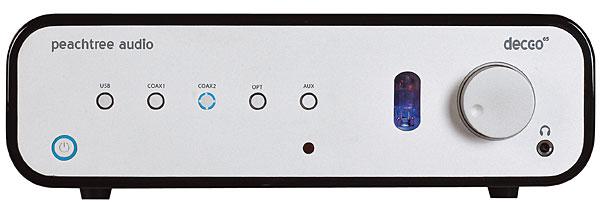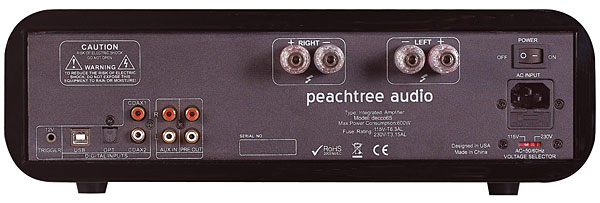| Columns Retired Columns & Blogs |
Unless you are a human FFT analyzer, figures 4 and 5 can't be seen as spectra.

In digital audio, time waits for no one—and so it goes here. The iDecco, which sold for $999, is no longer in the company's lineup, and while Peachtree continues to put iPod docks in various of their amps and preamps, today they're betting on a simpler yet more highly evolved addition to their stable: the decco65 ($999), in which a 65Wpc amplifier and a hybrid tube/solid-state preamp share space with a 24-bit/192kHz D/A converter.
Description
Much as they've succeeded in setting the right categories and price points for their products, so has Peachtree Audio found a winning formula for the decco65's industrial design: an attractive wood wrap—too curvy to be called a box—surrounding a chassis that's just big enough to contain its working parts and a bit of cooling space. The wrap, which comes in a choice of high-gloss black paint or, for $100 more, a veneer of cherry or rosewood, fits snugly around an elegant satin-finish panel, the latter including a soft-touch standby switch, a row of smaller buttons for source selection, a large volume knob, a headphone jack, and a clear plastic window for the decco65's single vacuum tube: a 6N1P dual-triode, used not for voltage gain but as an interstage preamplifier buffer. A button on the remote control allows the user to switch between tubed and solid-state buffering, the former indicated by a blue light at the center of the tube's socket; thus the window offers visual confirmation of an audible function that some may consider subtle.
Inside, much of the decco65's size and weight are accounted for by a large toroidal power transformer, with the remaining power-supply components located on the rear half of the main preamplifier printed circuit board. A class-D power amplifier, built around a Texas Instruments (née Toccata) Equibit chipset, occupies a 5.5" by 3.2" board of its own, approximately 30% of which is taken up by a single chunky heatsink. The amp board sits near the center of the decco65 chassis, itself formed from a single piece of thin-gauge steel and finished in textured black paint.
Alongside three other Peachtree products introduced at the same time—including the more powerful nova125 that Sam Tellig reviewed in January—the decco65 is the company's first product to offer a USB digital input capable of handling 24-bit/192kHz data, and operating in the preferred asynchronous mode. In the decco65 and nova125, the iDecco's ESS Sabre 9006 DAC chip has been replaced by ESS's 9023 chip. According to Peachtree Audio's David Solomon, the asynchronous USB datastream is clocked right at the DAC.
Installation and setup
During its time in my home, the Peachtree decco65 replaced the electronics in two different systems: For the first few weeks it sat atop a nothing-special bookshelf in my living room and drove my restored Quad ESL loudspeakers; for the serious listening that was the basis of the observations below, the decco65 drove my Audio Note AN-E SPe/HE loudspeakers and the review samples of DeVore Fidelity's Orangutan O/96 speakers, both in my 12' by 19' listening room. In the latter setting, the Peachtree occupied two different spaces: When playing CDs and LPs—the latter by means of a borrowed Leben RS 30EQ phono preamplifier—the decco65 sat on the middle shelf of a Box Furniture rack; when playing music files streamed through its USB input, it sat on a short pinewood table near my Apple iMac, to keep USB cable length to no more than 1m. Hookup was easy and logical; my only serious criticism of the decco65 from that perspective is its lack of more than one pair of line-level inputs. The hobbyist who wishes to use a phono preamplifier and a CD player—not to mention a tuner or a tape deck—will have to look elsewhere.

The decco65 became only mildly warm to the touch during use, no doubt aided in that regard by the metal cooling vents built into the top and bottom surfaces of its wooden wrap. Unfussy in its cabling requirements, it seemed perfectly happy with the fabric-sheathed, copper-conductor speaker cables from Auditorium 23 that have become my favorites over the past five-plus years. The decco65 didn't appear to invert absolute signal polarity when driven with line-level sources—my Sony SCD-777ES SACD/CD player, my AudioQuest DragonFly USB D/A converter, and the aforementioned Leben phono preamp—but I was slightly less sure when listening to its S/PDIF and USB digital inputs. I found myself very slightly preferring the sound with the polarity inverted at both pairs of output terminals, although those differences seemed smaller than usual, and did not, for whatever reason, call to mind to the sonic indicators I usually associate with correct and incorrect signal polarity. Go figure.

Sorry about the mislabeled graphs. I am traveling today but I'll fix this later today.
Update: Okay, got to where I was going today (flying from Seattle to Ashland Oregon) and have fixed the caption problem.
John Atkinson
Editor, Stereophile


Is the nova125 review available online?
Not yet, I m afraid.
John Atkinson
Editor, Stereophile

From the specifications of the amp section itself, it appears that the Decco65 is using the Texas Instruments TAS5613 150WPC class-D amplifier IC. This IC can deliver 65WPC into 8 ohms and 125W at 4 ohms with 1% THD, and claims both >90% efficiency and flat THD content across the entire audio bandwidth, with extended bandwidth to 80kHz. Pretty darn awesome for something the size of a postage stamp. The key to this, according to the TI data sheet for the IC, is their "PurePath HD" feedback scheme, which enables wide bandwidth and extremely low distortion (compared with other class-D ICs). A larger 300WPC amplifier IC is also available, the TAS5630. For those that are new to all this, an IC-based class-D amplifier builds everything but the input filtering caps and the output filter into the chip itself - which means the output devices are also onboard. A benefit to this is the extremely short signal paths on the amplifier IC's silicon die. By contrast, the popular ICEpower and Hypex UcD/nCore amplifiers use discrete components.
What this review says to me is that affordable class D amps (and particularly IC-based class-D amps) are finally "getting there" in terms of audio quality to where they can be used in a credible high-end audio product. I lost a channel in my class-AB amplifier recently and am using a Chinese stereo amp (Sinewave Genius200) based on the TAS5613 while the big iron is being repaired. Overall, my impressions mirror the author's - while not the last word in transparency, there is a wealth of detail being unveiled. Also, there are no sweeteners in the amp IC itself - tonally, it is on the neutral to cool side (like a class-AB amp based on bipolar FETs instead of MOSFETs). But the amp is remarkably free from the phasey 'hash' and elevated treble THD that I've heard from other class-D IC amps, mainly the low-cost Tripath variety or later ST Micro ICs (though the Tripaths were at least listenable), so imaging is much improved over what I've heard before from affordable class-D amps.
Still, the work is not done for engineers of class-D ICs, or those amp manufacturers that use them. Even the TI PurePath ICs are power-rated at THD levels (1% THD and 10% THD) that would be considered unacceptable in a Class-AB amplifier at full power, so there is room for improvement. (The TAS5613 is rated for 0.03% THD at 1W - the foregoing statement is only meant to highlight that at full power, class-D amps still have distortion issues.) Also, this indicates that class-D amps should actually be de-rated slightly when comparing them to similarly rated class-AB units to put them on equal footing where THD is concerned. Still, I am glad to see these improved class-D ICs making their way into higher-end products as their performance rises to the necessary level.
There is still some room for designers to affect the sound of these amps, even though the 'guts' are hidden inside the IC. What amp designers can do is make careful choices in the selection of input filtering caps and also in the design of a properly-damped output filter that provides maximal bandwidth and uses components designed for high voltage and high current applications, such as metalized film capacitors, potted large-gauge inductors, and high power resistors of good quality. A well-designed output filter will be more than a simple second-order lowpass LC network - it will include a parallel leg containing a shunting capacitor in series with a damping resistor to prevent additional HF distortion from voltage spikes that overwhelm the amp IC's feedback network. The math for output filter design is very simple, so when amp manufacturers leave this stuff out, I wonder what they are thinking other than trying to shave off every penny of cost - not a mindset that will succeed in the high end.
Lastly, to stay competitive, I'd like to see ICEpower A/S and Hypex Electronics BV create their own IC designs incorporating their patented technologies, such as a second feedback loop that monitors the output of the output filter and attempts to exert greater control via the amp stage. The very short signal paths on an IC would be of clear benefit to these already class-leading technologies.